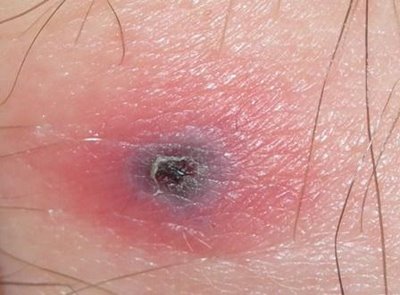Tick-borne disease: Difference between revisions
No edit summary |
No edit summary |
||
| Line 11: | Line 11: | ||
MeshID = | | MeshID = | | ||
}} | }} | ||
{{ | {{Tick borne disease}} | ||
'''For patient information click [[{{PAGENAME}} (patient information)|here]]''' | '''For patient information click [[{{PAGENAME}} (patient information)|here]]''' | ||
Revision as of 15:54, 14 December 2012
| Tick-borne diseases | |
 | |
|---|---|
| An eschar suggestive of tick bite |
For patient information click here
Editor-In-Chief: C. Michael Gibson, M.S., M.D. [1]
Overview
Tick-borne diseases are diseases or illnesses transmitted by ticks. As the incidence of tick-borne illnesses increases and the geographic areas in which they are found expand, it becomes increasingly important that health professionals be able to distinguish the diverse, and often overlapping, clinical presentations of these diseases.
Classification
Major tick-borne diseases include:
- Lyme disease
- Organism: Borrelia burgdorferi sensu lato (bacterium)
- Vector: deer tick (Ixodes scapularis (=I. dammini), I. pacificus, I. ricinus (Europe), I. persulcatus (Asia))
- Endemic to: North America and Eurasia
- Tick-borne meningoencephalitis
- Organism: TBEV aka FSME virus, a flavivirus
- Vector: deer tick (Ixodes scapularis)
- Endemic to: Europe and Northern Asia
- Rocky Mountain Spotted Fever
- Organism: Rickettsia rickettsii
- Vector: Dermacentor variabilis, D. andersoni
- Region (US): East, South West
- Vector: Amblyomma cajennense
- Region (Brazil): São Paulo, Rio de Janeiro, Minas Gerais.
- Babesiosis
- Organism: Babesia microti, B. equi
- Vector: I. scapularis, I. pacificus
- Region (US): Northeast West Coast
- Ehrlichiosis anaplasmosis (formerly human granulocytic ehrlichiosis or HGE)
- Organism: Ehrlichia chaffeensis, E. equi
- Vector: Amblyomma americanum, I. scapularis
- Region (US): South-Atlantic South-Central
- Relapsing fever
- Organism: Borrelia species
- Vector: Ornithodoros species
- Region (US): West
- Colorado tick fever
- Organism: Coltivirus
- Vector: D. andersoni
- Region (US): West
- Tularemia
- Organism: Francisella tularensis, A. americanum
- Organism: D. andersoni, D. variabilis
- Region (US): Southeast, South-Central, West, Widespread
- Tick paralysis
- Cause: Toxin
- Vector: D. andersoni, D. variabilis West
- Region (US): East
- Cytauxzoonosis
- Organism: C. felis
- Vector: D. variabilis (American Dog Tick)
- Region (US): South, Southeast
Pathophysiology
Tick-borne illnesses are caused by infection with a variety of pathogens, including rickettsia and other types of bacteria, viruses, and protozoa. Because ticks can harbor more than one disease-causing agent, patients can be infected with more than one pathogen at the same time, compounding the difficulty in diagnosis and treatment.
Diagnosis
Symptoms
Before symptoms develop, there is an incubation period of 5 to 7 days after the initial tick bite. The most common symptoms of tick bite fever include fever, headache, and an itchy skin rash with a central black spot. Other symptoms can vary in severity and include:
- Fever
- Headache
- Malaise
- Skin rash
- Confusion
- Arthralgias or swelling and pain in the joints
- Shortness of breath
- Palpitations
- Vomiting
Physical examination
A round red rash with a 2-5 mm central black area (eschar, an area of dead tissue)as shown in the photo is suggestive of a tick bite.
Laboratory findings
In general, specific laboratory tests are not available to rapidly diagnose tick-borne diseases.
Treatment
If there is a collection of pus, the area will need to be incised and drained. Antibiotic treatment is often justified based on clinical presentation alone. Doxycycline is often used to treat suspected tick borne-disease. Usually one dose is given to cover Lyme disase. An IV dose of a cephalosporin followed by Keflex 500 mg PO q 6 hours is given to treat the surrounding cellulitus. For hospital workers and others who have recently been in the hospital, bactrim twice a day is given to cover Methicillin resistant Staphylococcus Aureus(MRSA).
External Links
- Tickborne Diseases - National Center for Infectious Diseases (CDC)
- Tickborne Disease Website - Massachusetts Department of Public Health